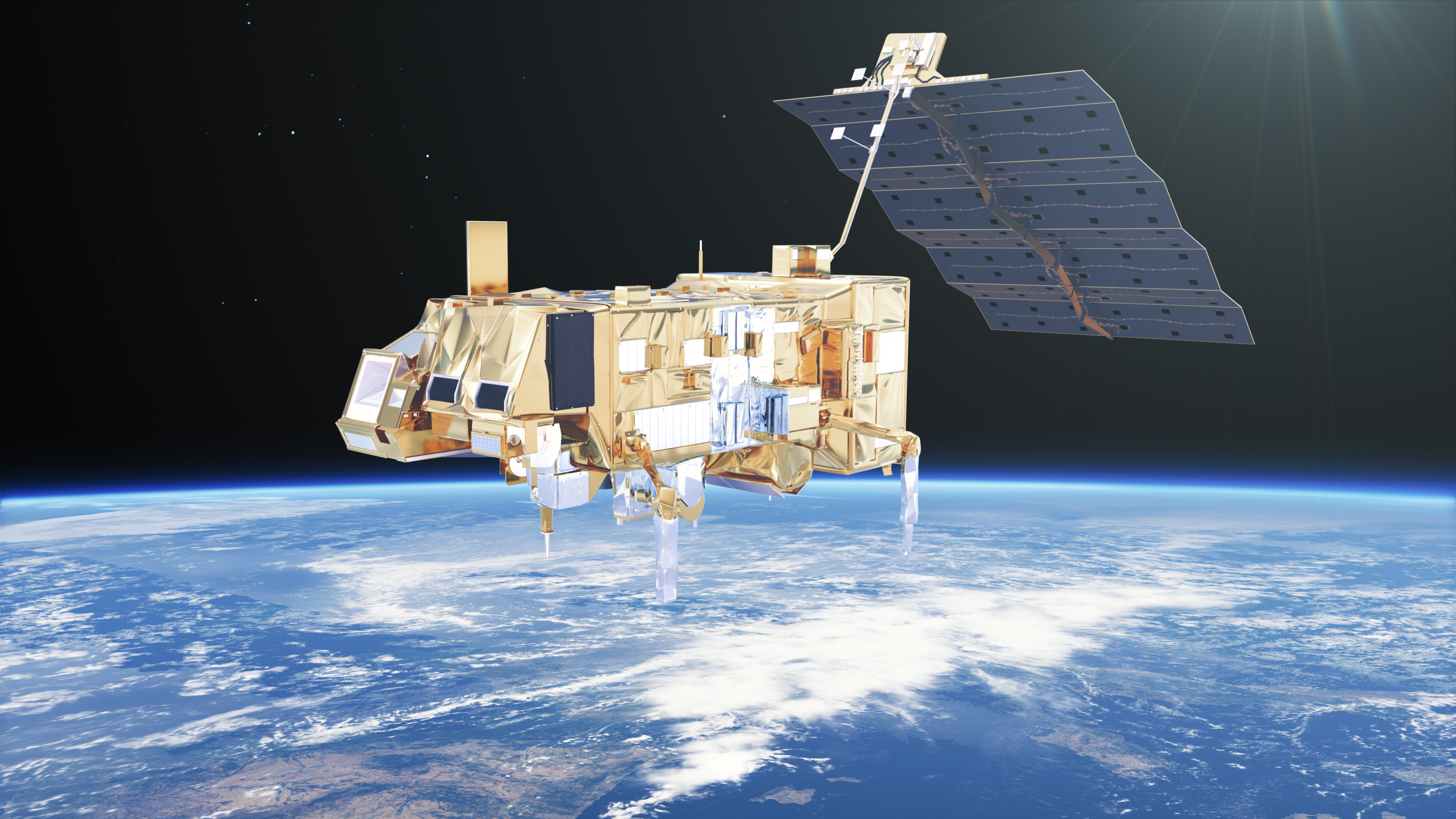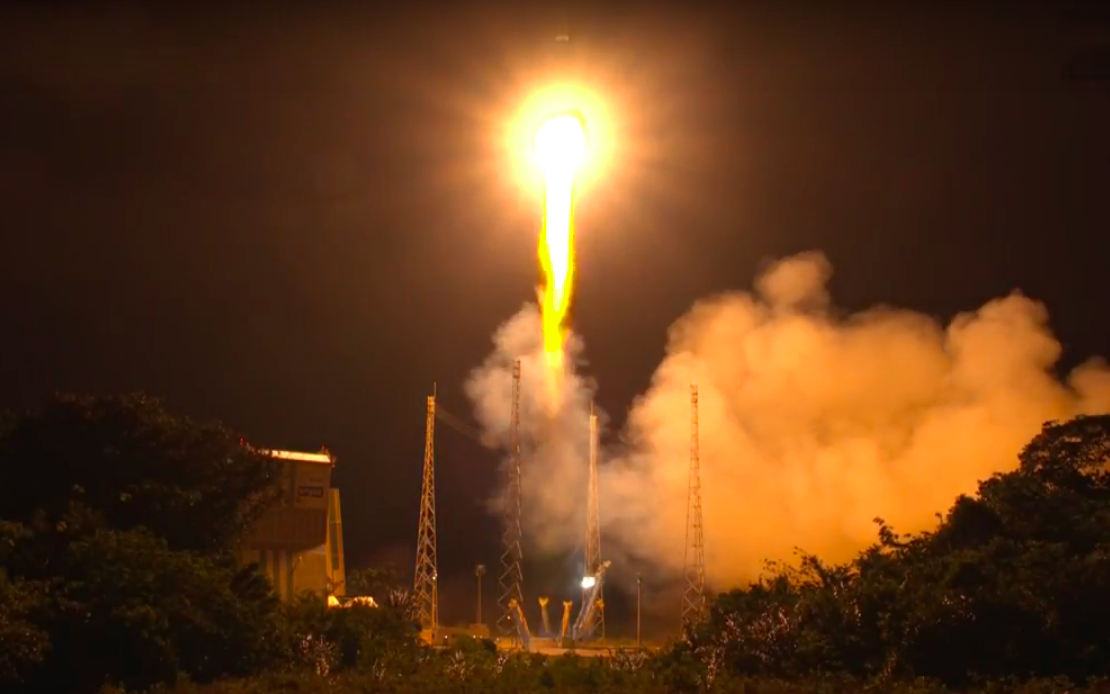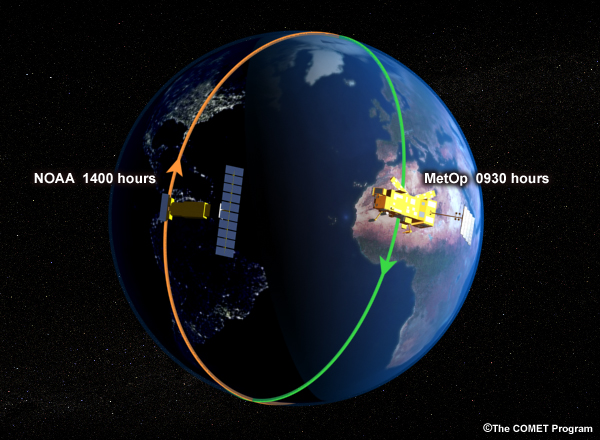Soyuz Rocket Launches European Weather Satellite MetOp-C Into Orbit
Europe's latest Earth-observation satellite blasted off into orbit today (Nov. 6) on a mission to improve weather forecasts and monitor changing climates around the globe.
MetOp-C, the third and final satellite of the European Meteorological Operational satellite program (MetOp), lifted off from the Guiana Space Center in Kourou, French Guiana, at 7:47 p.m. EST (0047 GMT on Nov. 7), on a European Soyuz rocket provided by the private launch company Arianespace.
"It was a superb launch, and everything went like clockwork," an Arianespace commentator said during a live webcast of today's launch. [Launch Photos! Europe's MetOp-C Soars Into Orbit on Soyuz Rocket]
This was the third successful Soyuz rocket launch since the Oct. 11 failure of a crew launch to the International Space Station on a Russian version of the Soyuz rocket. That failed launch suffered a booster separation issue that triggered an automatic in-flight abort, separating its Soyuz crew capsule from the rocket. The capsule parachuted safely back to Earth. Its crew, NASA astronaut Nick Hague and Russian cosmonaut Alexey Ovchinin, were unharmed.

About an hour after liftoff, the rocket's Fregat upper stage deployed MetOp-C into a nearly polar, sun-synchronous orbit just over 500 miles (800 kilometers) above Earth. In this type of orbit, the satellite is constantly exposed to sunlight as it circles between Earth's north and south poles. [In Photos: Europe's MetOp-C Weather Satellite Launches on Soyuz Rocket]
Its path will keep it on the daylight side of Earth's terminator, or the line between night and day, so "the satellite track along the Earth is always at the same local time, in this case in the mid-morning," European Space Agency (ESA) officials said in a description of the mission. All three MetOp satellites were built by ESA and are operated by the European Organization for the Exploitation of Meteorological Satellites (EUMETSAT).

MetOp-C's orbit complements the orbits of other weather satellites operated by the U.S. National Oceanic and Atmospheric Administration (NOAA). Like MetOp-A and MetOp-B, MetOp-C will join forces with NOAA's fleet of weather satellites through an international partnership between NOAA and EUMETSAT.
Get the Space.com Newsletter
Breaking space news, the latest updates on rocket launches, skywatching events and more!
"To provide enhanced coverage and a higher revisit frequency at mid latitudes, the Metop satellites fly in the 'mid-morning' orbit, while NOAA's JPSS satellites fly in the complementary 'afternoon' orbit," Arianespace officials said in a statement.

NOAA's Joint Polar Satellite System (JPSS) currently includes the Suomi NPP satellite and NOAA-20 (also known as JPSS-1). The agency plans to launch three more JPSS satellites by 2031, and EUMETSAT is already working on its second-generation fleet of MetOp satellites, called MetOp-SG, to begin launching in 2022.
The $550 million MetOp-C satellite has an operational lifetime of 5 years, after which it will be replaced by the second-generation satellites. Its predecessors MetOp-A and MetOp-B, which launched in 2006 and 2012, have both lasted beyond their expected 5-year life span and are still operational today. The three satellites were originally supposed to launch at 5-year intervals so each new satellite replaces the last, but thanks to their resiliency and some launch delays, all three of them will now be operational at the same time.
MetOp-C contains nine different scientific instruments that allow it to measure things like temperature, wind speed, humidity and ozone in the atmosphere. One instrument measures charged particles in Earth's radiation belts.
"These data are used mainly for numerical weather prediction – the basis for weather forecasting. Recent studies show that MetOp-A and MetOp-B have already reduced errors in one-day forecasts by as much as 27 percent," ESA officials said in a statement.
"The polar-orbiting Metop satellites are essential for numerical weather prediction from 12 hours to 10 days in advance," Arianespace officials said. "The still-operational Metop-A and –B satellites … make the single biggest contribution to the reduction in errors in weather forecasts one day in advance. Metop-C is therefore expected to enhance this."
Email Hanneke Weitering at hweitering@space.com or follow her @hannekescience. Follow us on Twitter @Spacedotcom and on Facebook. Original article on Space.com.
Join our Space Forums to keep talking space on the latest missions, night sky and more! And if you have a news tip, correction or comment, let us know at: community@space.com.

Hanneke Weitering is a multimedia journalist in the Pacific Northwest reporting on the future of aviation at FutureFlight.aero and Aviation International News and was previously the Editor for Spaceflight and Astronomy news here at Space.com. As an editor with over 10 years of experience in science journalism she has previously written for Scholastic Classroom Magazines, MedPage Today and The Joint Institute for Computational Sciences at Oak Ridge National Laboratory. After studying physics at the University of Tennessee in her hometown of Knoxville, she earned her graduate degree in Science, Health and Environmental Reporting (SHERP) from New York University. Hanneke joined the Space.com team in 2016 as a staff writer and producer, covering topics including spaceflight and astronomy. She currently lives in Seattle, home of the Space Needle, with her cat and two snakes. In her spare time, Hanneke enjoys exploring the Rocky Mountains, basking in nature and looking for dark skies to gaze at the cosmos.









